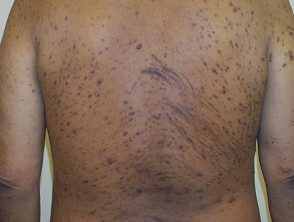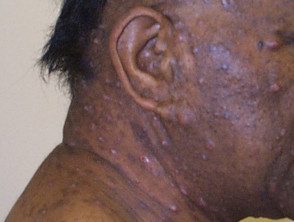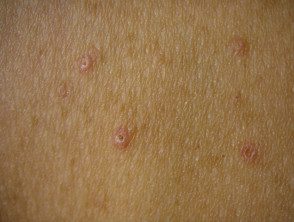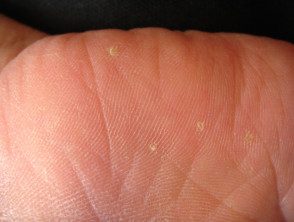What is reactive perforating collagenosis?
Perforating reactive collagenosis is a rare skin disorder in which collagen fibers extrude through epidermis (outer layer of the skin).
Two different forms of the disease have been identified:
- Inherited: manifests in infancy or early childhood
- Acquired: occurs in adulthood, usually in patients with diabetes or chronic renal failure, especially those who receive dialysis
The other major perforating disease is elastosis perforans serginosa.
Who gets reactive perforating collagenosis?
The hereditary form is a very rare condition with less than 50 cases reported in the world literature. Acquired reactive perforating collagenosis is more common, occurring in approximately 10% of patients receiving maintenance hemodialysis.
What causes reactive perforating collagenosis?
The cause of abnormal collagen extrusion through the epidermis is unknown, but lesions appear in response to the surface trauma like scratching and are aggravated by cold weather. This is particularly the case in the inherited form. The mode of inheritance is unclear, as reports from affected families reveal autosomal dominant and autosomal recessive inheritance, as well as sporadic cases.
In addition to affecting people with chronic kidney disease and diabetes, acquired reactive perforating collagenosis has been reported in patients with hypothyroidism (underactive thyroid gland), hyperparathyroidism (overactive parathyroid glands), liver disease and lymphoma.
What are the signs and symptoms?
In the inherited form, painless 1 to 6 mm in diameter keratotic papules develop in the extensor muscle surface of hands, elbows and knees after superficial trauma. Lesions start out as pin-sized lesions that over 3-5 weeks grow to papule about 6 mm. These resolve spontaneously in 6-8 weeks leaving minor residual scars. The lesions recur throughout life into adulthood. In some cases, cold weather conditions can trigger the reappearance of injuries
In acquired reactive perforating collagenosis, keratotic lesions develop on the trunk and extremities and are commonly associated with pruritus (Itch). Injuries are often, but not necessarily, related to superficial trauma.
Acquisition of reactive perforating collagenosis

Perforating collagenosis

Perforating collagenosis

Perforating collagenosis

Perforating collagenosis
How is it diagnosed?
Acquired reactive perforating collagenosis is diagnosed by clinical features. pathology Feautres in biopsy They are characteristic.
What treatment is available?
The injuries usually heal without any treatment, but they often recur. Treatments that have been used to treat and reduce injuries include:
- Isotretinoin
- Alopurinol
- Doxycycline
- Phototherapy
Emollients and oral antihistamines are helpful in relieving itching in the acquired form of the disease.
